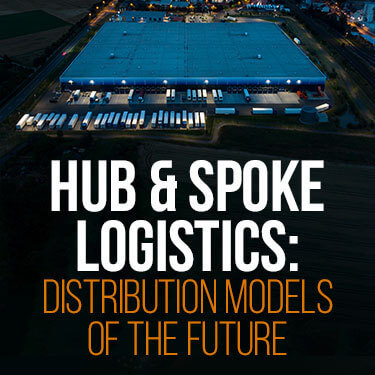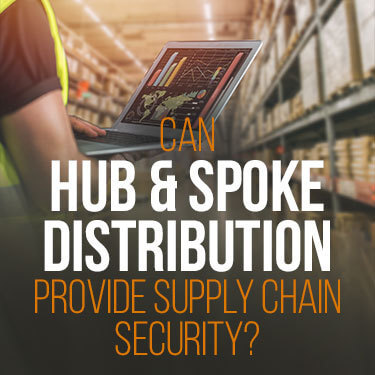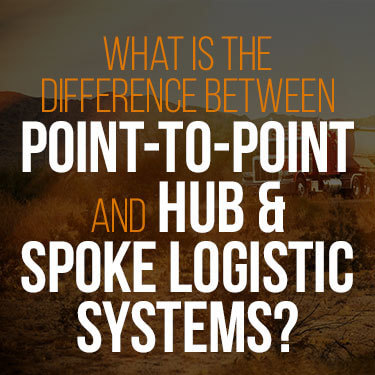
 Copy URL to Clipboard
Copy URL to Clipboard
Hub & spoke logistics isn't a new concept but it's getting a new appreciation. Major airlines have organized their flight paths with hub and spoke models since the 1950s. The tech industry used it to set up their computer networks. See how the transportation industry is now utilizing this distribution model to save money and provide better service.
Hub and spoke distribution models for the transport industry mimic the layout of a bicycle wheel. The center hub is the distribution center while the spokes are routes for outbound delivery. Hub and spoke logistics focuses on strategic placement and on finding ways to maximize efficiency for cost and speed of delivery.
Learn how the hub and spoke distribution models are improving the services your carrier can provide.
Table of Contents

The hub and spoke distribution model is meant to provide centralized infrastructure. It most resembles a bicycle wheel with a hub and spoke and like a wheel. It needs to be laid out correctly to prevent collapse.
At the center, a well-built and managed distribution center can process packages for final delivery. The routes are designed to have drivers make the most deliveries in the least amount of time while remaining fuel-efficient.
Depending on the size and scope of a carrier’s operation, these centers may be located between large cities or even within a city. Location is crucial when using this model for your transportation management system. The placement of the distribution center should make it possible for all the delivery paths to be capable of same-day delivery promises.
If the operation is large enough, a company may establish more than one distribution hub. In this instance, each wheel would function a bit like a cog as well. If a package needed to go from one part of the country to another, the end of the “spoke” could be a meeting place for item transfers between centralized locations.
Improving freight transport often means improving efficiency wherever possible. More efficient systems cost less and allow operations to run smoothly. Hub and spoke systems were originally adopted by freight airlines who wanted to make sure that planes were flying out with a full load of cargo. In today’s trucking industry, the goal is the same.
In centralizing the distribution network, major warehouses always have goods to deliver. While smaller, regional warehouses do have their place, it can be a struggle to send out LTL trucks with full trailers. It isn’t that empty trailers don’t make money (which they don’t), but that empty trailers still cost money, money that they aren’t earning back.
Same-day or next-day delivery has become the standard in many places. To fulfill what has become a common expectation, carrier services may drive in opposite directions throughout the day. Hub and spoke distribution models provide a better alternative.
Optimizing delivery routes can take a few forms:
When delivery managers can plan using set paths for the majority of deliveries, the occasional last-minute delivery change can be handled with more grace. A driver who becomes increasingly familiar with one or two assigned areas is also able to navigate with efficiency. They will also become familiar with routine delivery stops which speeds up the drop-off process.
Routine deliveries with familiar faces may provide customers with a sense of comfort and personalization. Happy customers will keep signing on for services.
While the start-up costs of building a hub & spoke network is significant, benefits begin right away. The central hub of a network needs to be large enough to accommodate various items and have enough docks for multiple trailers to be loaded or unloaded at the same time.
Companies will always need to account for logistics costs. On average, 10% to 35% of a company’s revenue is funneled back into logistical expenses. The majority of that tends to be geared towards transportation. For a carrier, those may be higher since the entire business revolves around transport.
With good warehouse management and transportation management systems, facilities can make continuous progress with deliveries and avoid any hurry-up-and-wait scenarios that slow down business.
Logistical costs are lowered and simplified when:
Companies that have adopted the hub and spoke system report significant savings in overall distribution costs. These savings allow companies to recoup the start-up costs quickly while improving customer satisfaction.

Securing a supply chain is a multi-faceted and ongoing process for retail companies everywhere. In terms of securing a supply chain from a logistical point of view, there are three parts to consider.
The more integrated and efficient these three parts are, the better supply chain security will be. Companies rely on carriers who can provide such security. Carriers themselves are aware they are protecting multiple supply chains at once.
Hub and spoke logistics can help build and maintain the integrity of all three parts that lead to the establishment of a secure supply chain. The hub and spoke model works especially well with LTL carriers.
In LTL transportation, the shipments of multiple companies may be on the same truck. The technology required for the adoption of a hub and spoke network allows all packages to be scanned, sorted, and loaded into a truck headed into a single general direction.
Merchandise from the same company is therefore stored together safely, packaged together for LTL delivery service, and kept along a pre-determined route.
All of this makes it possible to:
If you are worried about the security of your supply chain at the logistical level, partnering with a well-established 3PL that uses hub and spoke distribution models for effective resource management is an idea you should be looking into.
The use of hub and spoke distribution models can be applied to various different industries. The model is not limited to transportation and fulfillment.
Other industries that employ hub and spoke models include:
The applications for each of these industries can be studied to see how they may apply across different circumstances.
In the world of distribution and fulfillment, individual businesses with many locations and who process a large volume and variety of goods would benefit the most. Certain big box stores have been using this model to connect more easily with their vendors. By choosing optimal locations, they can then deliver those packages to multiple retail stores in a short time span.
The transport industry that greatly benefits from hub and spoke logistics are 3PL companies. Contracted by brick-and-mortar stores as well as eCommerce businesses, 3PLs are forever looking for ways to better support their clients.
For smaller businesses that can’t justify establishing their own delivery system, 3PLs provide access to space, technology, and resources to compete with large retailers. You could gain all the benefits of an advanced management system in a manner that is cost-effective for your business needs.

In pointing out the differences between the two systems, it’s important to remember that there are instances where one will be better than the other. Just as there are varied business models, there are different logistics models to meet all kinds of needs.
By definition, point-to-point logistic systems are networks where one point is connected to another point. Anything traveling from point to point does so directly; there is no stopping.
Hub and spoke logistics have a central hub that may connect to several different points in a network. When transporting from a central hub, the expectation is to make stops along the route for multiple deliveries to be completed.
LTL carriers will traditionally benefit more from a hub and spoke system than from a point-to-point network. The chances of every shipment on an LTL truck going to one destination are almost non-existent. In most cases, it will only happen when shipments are moved from a consolidation center into a fulfillment center.
Smaller companies that target specific routes may benefit from point-to-point systems. Any truck moving out of the port of Los Angeles is likely to have a full load. Due to the number of containers that enter the port, a set point to a local warehouse may not pose an issue.
By contrast, trying to get a full load from Los Angeles to Wichita, Kansas on a regular basis will be more difficult. This is where a company may prefer to establish a hub in a center point of the Midwest which could reach cities such as Wichita and Denver.
Safe and reliable fulfillment and distribution services are available by partnering with R+L Global Logistics. Our warehouses are located among several major cities from Los Angeles to Atlanta.
These central locations make our hub and spoke distribution model a possibility. By taking advantage of new technologies, we have created fulfillment warehouses so your business shipping needs can be met all over the U.S.
Our services include:
Get a service quote today and see how we help you ride in circles around the competition.
